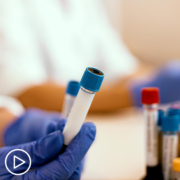What You Should Know About Progression in MPNs
What You Should Know About Progression in MPNs from Patient Empowerment Network on Vimeo.
Dr. Srdan Verstovsek provides an overview of myeloproliferative neoplasm (MPN) progression and reviews indicators that essential thrombocythemia (ET), polycythemia vera (PV) or myelofibrosis may progress.
Dr. Srdan Verstovsek is Chief of the Section for Myeloproliferative Neoplasms in the Department of Leukemia at The University of Texas MD Anderson Cancer Center. Learn more about Dr. Verstovsek, here.
Related Resources

Should MPN Patients Be Retested for Genetic Mutations Over Time? |

|

|
Transcript:
Dr. Srdan Verstovsek:
When we talk about ET and PV, they should be life-long conditions without much of a change. It’s uncontrolled blood cell count and thromboembolic events, which are then subject to a therapy, and the goal of therapy is to decrease the thromboembolic risk.
There is still, in some smaller proportion of the patients, a risk of a disease change on its own. We talk about the genetic testing that can reveal a change in genetic complexity of the disease, which may be responsible for a change down the road. Or abnormalities in chromosomes that can be seen at the time of diagnosis in some of the patients with ET and PV, not very often, which may predispose patients to a change down the road, a change to more aggressive condition.
So, a smaller proportion of the patients, perhaps 10 – 20 percent of the patients between ET and PV, can over time, long time, acquire fibers in the bone marrow.
That can lead to anemia actually, progressive increases in spleen, bone marrow cells in blood, that would be then a change to myelofibrosis. And a very small percent of the patients actually can change to acute myeloid leukemia, with the baby cells in the blood and the bone marrow, these are called blasts.
They should not be in the blood in the wrong person. They should be below 5 percent in bone marrow in normal person, but if they go above 20 percent, we call that acute leukemia.
So, transformation of ET or PV to myelofibrosis or acute myeloid leukemia, are fear, and obviously can lead to a shorter life expectancy. And so, one can certainly worry about that, but again, it is in a smaller proportion of the patients, and we don’t usually worry that much about it. However, the worry does exist, that’s why you are asking me about it, and the problem is we don’t have medication that would be known and proven in prevention of that biological change of the disease in some patients.
In myelofibrosis it’s similar situation, 20 – 25 percent of the patients change to acute myeloid leukemia, and we don’t have real medication that would be preventing that change.
Promising ET, PV & Myelofibrosis Therapies in Development
Promising ET, PV & Myelofibrosis Therapies in Development from Patient Empowerment Network on Vimeo.
MPN specialist, Dr. Srdan Verstovsek discusses the latest research and progress for the treatment of patients with essential thrombocythemia (ET), polycythemia vera (PV) and myelofibrosis (MF).
Dr. Srdan Verstovsek is Chief of the Section for Myeloproliferative Neoplasms in the Department of Leukemia at The University of Texas MD Anderson Cancer Center. Learn more about Dr. Verstovsek, here.
Related Resources

An Expert Shares Key Steps to Take Following an MPN Diagnosis |

|

|
Transcript:
Dr. Srdan Verstovsek
When we talk about the new therapies in development, there are many in myelofibrosis in particular, and a few are in essential thrombocythemia and polycythemia vera. Let’s start with ET and PV. Here we are expecting either studies, or possibly even approval, of a long-acting interferon called Ropeginterferon that was approved a year ago in Europe for PV patients.
We gonna have, hopefully here in the United States, that drug for our patients in a year or perhaps studies in PV, or perhaps most definitely, I would say, studies in ET with this drug. That would be enhancement of what we done off-label using interferons that are approved for some other conditions. We know that interferons are biological agents active in these conditions to control the bone marrow, and perhaps even decrease the number of malignant cells in the bone marrow of patients with ET and PV, which may be beneficial down the road.
In myelofibrosis, the picture is completely different. In this setting, the life expectancy, unfortunately, is affected as we discussed, and we need therapy that would be perhaps improving that life longevity. As we know, the ruxolitinib JAK inhibitor that has been around for nine years can extend the life a few years, but not cure people.
So, helping JAK inhibitors by combinations with other active agents that would be biologically modifying that bone marrow, decrease the tumor burden, improving the quality of life or anemia, are at forefront of what is happening right now. So, combinations with Navitoclax which is Bcl-xL cell inhibitor, CPI-0610, which is BET inhibitor, Luspatercept which is anemia drug.
These are phase three studies that are planned to start soon for possible approval for combinations over JAK inhibitor alone for different problems that people face.
Or, later on in the course of the disease, JAK inhibitor may fail. What do you do then? So, we have studies announced that will be done in what we call a second line, after-JAK inhibitor. And the MDM2 inhibitor was announced. Imetelstat inhibitor in the second line. Momelotinib JAK inhibitor in the second line. Fedratinib is being studied, another JAK inhibitor. Pacritinib for patients with low platelets
These are all phase three studies. That’s means for approval of this drug, so that will be three and four, seven different phase three for myelofibrosis patients with different clinical scenarios, different clinical problems are being done, or about to be done, in very near future. So, my prospect is here. My view on that is that we will have, hopefully, at least some of these seven studies leading to approval of some new drugs for our patients with myelofibrosis.
Monitoring MPNs: When is it Time to Switch Therapies?
Monitoring MPNs: When is it Time to Switch Therapies? from Patient Empowerment Network on Vimeo.
MPN expert, Dr. Srdan Verstovsek reviews factors that may indicate a treatment change for patients with essential thrombocythemia (ET), polycythemia vera (PV) and myelofibrosis (MF).
Dr. Srdan Verstovsek is Chief of the Section for Myeloproliferative Neoplasms in the Department of Leukemia at The University of Texas MD Anderson Cancer Center. Learn more about Dr. Verstovsek, here.
Related Resources

Should MPN Patients Be Retested for Genetic Mutations Over Time? |

|

|
Transcript:
Dr. Srdan Verstovsek
The real definitions of a failure of a given therapy, it’s not easy to come by. Experts in the field, doctors that see a lot of myeloproliferative neoplasm patients, occasionally get together and try to put in place some guidelines. What would be a failure to a therapy mean for patients with ET or PV?
Would that be, for example, polycythemia vera patients too many phlebotomies when you are on hydroxyurea.
Hydroxyurea is a chemotherapy by mouth, should be eliminating need for phlebotomy, should decrease the white cells and platelets, and the spleen enlarged, and improve the quality of life.
If that’s not possible, and you have to define what that means, then you would say, you should change. So, guidelines do exist, which are always used in clinical studies to define the failure and justify a change. But they should also be applied in clinical practice to apply possible.
If you are on hydroxyurea for ET and PV, and you are not controlling blood cell count very well, you can’t take more because there are side effects from hydroxyurea, you should change. Right?
If you see a progression of the spleen, or worsening of quality of life despite the control of the blood cell count, something is wrong, maybe you should change.
In myelofibrosis is similar situation. You may be experiencing a good therapy on JAK inhibitor or anemia medication, but then after a while, spleen starts to grow, quality of worsens, or anemia develops, then you should change.
It’s not as easy to see exactly to define, but you get the point I’m sure because people are different, the benefit extent or benefit is different, pattern of a failure is different, and we have a lot of difficulties in really objectifying what this means to fail.
My approach is when I see a failure developing – nothing happens overnight. You try to modify what you do by adding another medication, adding medications for whatever is causing that failure, or modifying what you’re doing by changing the schedule or the dose. So, not to give up and say, “Oh, it’s not working,” but trying to work with the patient, and with the medications that you have in different way, for benefit to last the longest possible.
Which MPN Treatment is Right for You? Factors to Consider
Which MPN Treatment is Right for You? Factors to Consider from Patient Empowerment Network on Vimeo.
Dr. Srdan Verstovsek, discusses how multiple factors, including diagnosis and symptom burden, determine which MPN treatment path may help improve a patient’s outcome.
Dr. Srdan Verstovsek is Chief of the Section for Myeloproliferative Neoplasms in the Department of Leukemia at The University of Texas MD Anderson Cancer Center. Learn more about Dr. Verstovsek, here.
Related Resources

|

|

An Expert Shares Key Steps to Take Following an MPN Diagnosis |
Transcript:
Dr. Srdan Verstovsek
So, we talk about diagnosis, and then prognosis, and then go over [stem cell] transplant. Now, the transplant is done in only less than 10 percent of the patients because most of the patients are elderly. That’s why you have the disease.
They might not have a donor. They may be sick. There are multiple reasons, so transplant happens in less than 10 percent of the patients. Once we are over that, you say, “What’s wrong with the patient?” Not wrong in terms of dying, but do you have a significant anemia? Do you have an enlarged spleen? Do you have a bad quality of life when we talk about myelofibrosis? All of this that I have talked so far, applies to myelofibrosis. These are the three main reasons for initiating of therapy, usually. Significant anemia, significant bad quality of life, and significant symptom related to the big spleen. You would then introduce therapies.
For the splenic symptoms, we usually prescribe JAK inhibitors. That would be standard practice. For anemia, we have medications from injections under the skin, to some pills. No real approved therapy for anemia, but whatever we can do help patients counteract those problems because slowly over time they’ll get worse and worse, and people die with myelofibrosis between five and seven years.
So, we wanna combine medications. We’re gonna introduce medications as soon as something wrong with the patients to improve whatever is wrong so that the quality of life can continue at a decent level.
Let me go back a little bit to essential thrombocythemia and polycythemia vera, ET and PV. These two conditions are considered rather benign. They should not much effect the longevity, perhaps PV can. And if they do, the main reason for dying from ET and PV is the blood clot or thrombotic event.
This is what we say, usually. A blood clot or some bleeding usually clots in the heart, or the brain, or the lungs, can kill the person. So, we don’t usually talk about the life expectancy in terms of genetic mutations, or abnormalities in chromosomes, or something that will kill the patient outside of the blood clotting risk.
So, what we are talking about then, is after diagnosis, we are talking about the prognosis, when we talk about ET and PV, prognosis is related to what’s your thrombotic risk? So, we talk to patients with ET and PV about thrombotic risk assessment.
And typically, age over 60, or having a history of blood clot, we’ll say yes that patient is a high risk patient with ET, or high risk patient with PV, for the blood clot. And we will be treating patients for that risk in different ways.
So, it’s a little bit different angle here on what we try to achieve in ET and PV patients. More benign, more chronic, assessment of the risk of clotting and control the blood count, and occasionally when we need, control the spleen symptoms. But different ballgame and ballpark then the myelofibrosis part.
There are, obviously, standard practice protocols in terms of what do you do? Right? So, if we are talking about ET and PV, you would say, if you are – as your remember now, we divide patients in those with the low risk of blood clot, and high risk for blood clot. For low risk, we just give people baby aspirin, and if they have PV, we phlebotomize the patients, blood-letting.
So, not much experimentation there. But there are studies that one can join if there are too many phlebotomies, for example, too many blood-letting episodes. And there are studies with medications that would be decreasing that need completely.
There are also studies in patients that are high risk for blood clotting, which typically would be treated with hydroxyurea, chemotherapy by mouth.
There are new versions of the interferons, biological agents given under the skin every two weeks, that would perhaps be taken instead of a standard practice hydroxyurea.
Not too many studies in ET and PV, really. Some. But in myelofibrosis, there are many because with ruxolitinib, for example, which has been around for about nine years, it’s a JAK inhibitor, you get in many patients good control of the splenic symptoms, but it does not last forever, and in some patients, it may benefit to some degree, but not completely.
So, there are many studies where you can add another medication to ruxolitnib a JAK inhibitor, to boost what it does more of the splenic symptoms controlled, or to add another benefit. The JAK inhibitors do not, by and large, improve the anemia, so how about adding anemia drug to ruxolitnib.
So, combination studies are many underway, so you can actually enroll – even with the newly diagnosed myelofibrosis patients, in the need of therapy, in a clinical study. Not to say, after JAK inhibitors in a second line. That’s what we call it. After JAK inhibitors you need to do something else, that second line, there are many studies because there is no other approved therapy. So, for myelofibrosis, no question in my mind, there are so many studies underway, you can be participant in study to get your result boosted by whatever else is added to what you’re doing, and discover for the large population of patients, novel therapies.
MPN Treatment: Why Testing for Mutations Matters
MPN Treatment: Why Testing for Mutations Matters from Patient Empowerment Network on Vimeo.
Testing for mutations can influence treatment options available to patients with MPNs and provide a more in-depth understanding into their essential thrombocythemia (ET), polycythemia vera (PV) or myelofibrosis (MF) diagnosis. MPN specialist, Dr. Srdan Verstovsek reviews three key mutations that may impact treatment timing and approaches.
Dr. Srdan Verstovsek is Chief of the Section for Myeloproliferative Neoplasms in the Department of Leukemia at The University of Texas MD Anderson Cancer Center. Learn more about Dr. Verstovsek, here.
Related Resources

|

|

|
Transcript:
Dr. Srdan Verstovsek:
So, what we know is that ET, PV, and MF, these are these three, and we will use the abbreviations for simplicity, are so-called classic myeloproliferative neoplasms. Myeloproliferative means that it is disease of the bone marrow where cells grow without control.
Now, with ET we have high platelets, but ET is the disease of all the cells. In PV you have high red blood cells, and in many patients you have high white cells and platelets. In myelofibrosis, it’s paradoxically many patients present with too few cells because of reactive bone marrow fibers or fibrosis that limits the growth of the cells.
So, these are the three diseases that have underlying problem, same problem in these three conditions, which is high activity of proteins inside the bone marrow cells, proteins inside the bone marrow cells.
A cascade of protein that makes cells grow without control. We call this a JAK-STAT pathway. I had patients; they say JAK-STAT highway. It’s active all the time. This is a protein JAK too, and then the JAK2, and then other, so we call it JAK-STAT pathway.
It’s super active. Active in normal person when we need to make blood, but in the diseased person, active because of acquired mutations that affect that highway, JAK-STAT pathway or highway.
It makes it work all the time, that’s why we have so many cells. And there are three mutations, which are part of diagnostic process. You test for these. You can test in the blood or in the bone marrow sample, and these are JAK2 mutation, calreticulin mutation, and the MPL mutation.
They are almost always exclusive of each other, and about 90 – 95 percent of patients will have one or the other. They are still very few patients that have none of these three, which is interesting. And we are, in others, looking for other reasons in these few patients.
But one of the three is present, and it’s part of the diagnostic process as well. I didn’t emphasize this before, but it is present as a part of the bone marrow evaluation. That’s where it goes. And it is therefore, helpful to test for it. But one can test for other mutations. Many patients have many other mutations that have nothing to do with the JAK-STAT pathway, and that in large part is responsible why people have different disease ET, PV, or myelofibrosis. We explain this that way because of other genetic abnormalities, other abnormalities that we cannot really describe yet.
Genetic is not the whole picture. There are other parts, I’m sure, in bone marrow environment, in other factors they control the genetic expression, and so on, that contribute why a patient with JAK-STAT hyperactivity has ET, and why another has myelofibrosis.
We don’t really fully understand that. And of course, there is a plethora of patients in between that are not all the same. So, genetics do carry a lot of weight in what happens with the patients, and we do test for that, in addition to testing for JAK2, calreticulin MPL. We test for multiple others. That’s routinely done in academic center. It’s very valuable, and it should be standard practice.
The main utility of widespread testing for additional mutations is to assess the prognosis of the patients. If we are looking at the bone marrow blood chemistry and physical exam, a splenomegaly, and presence of this driver mutation, the JAK, calreticulin or MPL.
We call them driver mutations. They drive that highway. If that is the complexity of the diagnosis, then the next step is, as you remember, the patient will say, “How long I’m gonna live?” Well, obviously, that information comes from the historical experience, and I always emphasize that. But there is valuable information from historical perspective to some intelligence to tell the patients what to expect in general terms. Since the introduction of the genetic testing in academic centers, we have enhanced our ability to prognosticate. Initially, ten or more years ago, we would be looking at the age of the patients, how the patient fares, the symptoms, the anemia, or white blood cell count, or blasts.
These would be kind of common prognostic factors for assessment of the outcome of the patients. But now, we add information on the presence of one or the other of the driver mutations, and the presence of the number and types of these other additional, which call them somatic mutations that have nothing to do with JAK-STAT pathway.
And you can see now how the prognostication also has the flavor of complexity, and it is really not that easy, and we keep moving forward. That prognostication effort is keep moving to assess the outcome of the patients better and better for one particular reason.
If we have we a sense that a patient, based on this prognostic scoring systems, have a poor outcome, which we define as the life expectancy less than five years, then that patient should be referred to the [stem cell] transplant.
And transplant should be done because the benefit of a cure, and the risk of dying through transplant procedure – unfortunately, that’s the reality, is just justifiable if the prognostic scoring system tells you that the life expectancy is less than five years.
That’s the main role for the genetic complexity testing. Looking also at the chromosomes that might be broken. That’s done on a bone marrow sample. And dividing patients in prognosis scoring groups to guide the decision making on the transplant.
Should MPN Patients be Retested for Genetic Mutations Over Time?
Should MPN Patients be Retested for Genetic Mutations Over Time? from Patient Empowerment Network on Vimeo.
MPN expert, Dr. Srdan Verstovsek provides insight into what factors determine whether MPN patients should undergo additional bone marrow biopsies and genetic testing over time.
Dr. Srdan Verstovsek is Chief of the Section for Myeloproliferative Neoplasms in the Department of Leukemia at The University of Texas MD Anderson Cancer Center. Learn more about Dr. Verstovsek, here.
Related Resources

Diagnosed with an MPN? Why You Should Consider a Second Opinion |

|

|
Transcript:
Dr. Srdan Verstovsek:
We already know, everybody knows, I would think, that the living tissue does change over time. And when a patients have doubt, I tell them, “Look, my hair has not been grey all my life.” Everybody laughs. That happens with the bone marrow biopsy results, right? They change over time because the bone marrow does change over time. It’s not the same, and if you have the disease, disease cells, let’s call them malignant cells, they may acquire new mutations as they divide. If they already have some mutations that they’re present at the time of diagnosis, they are actually more prone to get more of those mutations over time.
And so, it may then be wise, and that’s what your question is about, to occasionally test patients and see whether there’s any change. Not perhaps in the number of fibers, or number of different cells, but genetically are there any new mutations which would make that disease perhaps more aggressive.
Unfortunately, the situation with repeated testing is complicated by price of the test. The testing can be done on blood, but it’s very expensive. We’re talking about thousands of dollars, and it’s not justifiable at the moment to do that every six months, or once a year for example, to see about any change because, it may not change what we do. It requires a clinical change, not just a genetic change for one to do something different, and something different would be referral to a bone marrow transplant, sooner rather than later.
So, first of all, repetitive testing would be useful in patients that are borderline for the decision of the transplant, not in everybody, because that’s the only intervention that would be affected by that testing. And then, even in these situations, you would need to have a clinically relevant abnormalities beyond just a new mutations.
That means a bigger spleen, or losing weight, or having profound anemia now. So, what basically this comes down to is, we follow the patients closely, and when there is a clinically relevant change, that would ask for a bone marrow biopsy and genetic testing, then we can justify that, and then we change what we do. So, it is cumbersome to sit tight and wait for a change, I understand that, but that’s the reality at the moment.
Which Tests Are Necessary Following an MPN Diagnosis?
Which Tests Are Necessary Following an MPN Diagnosis? from Patient Empowerment Network on Vimeo.
MPN expert, Dr. Srdan Verstovsek, explains why a bone marrow biopsy is essential following a myeloproliferative neoplasm (MPN) diagnosis and its role in confirming whether a patient has essential thrombocythemia (ET), polycythemia vera (PV) or myelofibrosis (MF).
Dr. Srdan Verstovsek is Chief of the Section for Myeloproliferative Neoplasms in the Department of Leukemia at The University of Texas MD Anderson Cancer Center. Learn more about Dr. Verstovsek, here.
Related Resources

An Expert Shares Key Steps to Take Following an MPN Diagnosis |

|

|
Transcript:
Dr. Srdan Verstovsek:
By and large, we would like people to have a bone marrow biopsy done. In fact, I would say that myelofibrosis cannot be diagnosed without a bone marrow biopsy. Polycythemia vera, in occasional cases, can be diagnosed without the bone marrow biopsy, even by the national guidelines. And essential thrombocythemia, I would say, that should have, although that is not norm in clinical setting, a bone marrow biopsy as a part of the disease diagnostic process.
This is to say that the diagnosis of any of these three conditions, ET, PV, or myelofibrosis, does not depend solely on the bone marrow biopsy.
I’ll give you an example of the myelofibrosis. You have to have a biopsy that shows abnormalities in different cells in the bone marrow. Megakaryocytes are the key. So, cells are different in number, size,shape, and colors, and you have fibers. Sometimes you don’t even have a fibers. But then, you have to combine this.
Maybe, abnormalities in blood cell count. In the blood chemistry there is an LDH, lactate dehydrogenase chemistry test that usually is tested for. And then, you have a physical exam, enlargement of the spleen. And the type of the white cells in the blood. So, you have a combination of the bone marrow, blood chemistry test, and the physical exam that all have to come together for diagnosis to be made for myelofibrosis.
I always ask my fellow, and doctors in training, who actually makes the diagnosis? It’s the clinician. If you just look at the bone marrow, you may say there is myeloproliferative neoplasm and there are some fibers, but you have to have these other factors to make a diagnosis of myelofibrosis. And fibers, for example, do not really say that the patient has myelofibrosis. Fibers can be present in PV, polycythemia vera, in 20 percent of the patient at the time of diagnosis of PV.
So, fibers on its own doesn’t mean myelofibrosis. Of course, there are other diseases that can cause fibers, other bone marrow diseases that have nothing to do with myelofibrosis or polycythemia vera.
So, it is rather complex problem, and it is not easy to make a diagnosis. We actually looked at that, and 15 percent of the patients that come through the door here at MD Anderson, have a change in diagnosis after our own assessment. So, some experience does count, I would say does counts a lot, because of complexity.
MPNs and Coronavirus: What Patients Should Know
MPNs and Coronavirus: What Patients Should Know from Patient Empowerment Network on Vimeo.
Dr. Srdan Verstovsek provides guidance for patients with myeloproliferative neoplasms (MPNs) related to coronavirus (COVID-19), stressing the necessity of continued communication with their healthcare team.
Dr. Srdan Verstovsek is Chief of the Section for Myeloproliferative Neoplasms in the Department of Leukemia at The University of Texas MD Anderson Cancer Center. Learn more about Dr. Verstovsek, here.
Related Resources

An Expert Shares Key Steps to Take Following an MPN Diagnosis |

|

|
Transcript:
Dr. Srdan Verstovsek:
When we come to the COVID pandemic here, and the effect on our patients with myeloproliferative neoplasms, of course, that is something that is very serious. Our patients, particularly those with advanced myelofibrosis, are at a high risk of having complications from infection if they get infection. Perhaps less so for patients with ET and PV, which are more healthier, if you like, although they have myeloproliferative neoplasms.
So, our focus here is, first of all, like it is for anybody else, including myself, on prevention.
Obviously, that would be common sense and logical to try to prevent getting infected. And then, also to try to be in best possible health. Taking medications as prescribed. Being in touch with your doctor. If you cannot come to a physical exam, which is understandable because of possible increased risk through the transportation perhaps, then being in touch through telemedicine. We call, and we see our patients online. That is fine. We can do the bloodwork from the distance.
So, taking medications, being fit, and being as healthy as you can with the disease. But taking medications and controlling your risks, not allowing disease to take ahold of you, and then you get infection and you’re gonna be in trouble.
So, really communications with the doctors, taking medications, and I would say, occasional, with all precautions, visits.
Because, for example, with myelofibrosis patients, I really need to feel that spleen and the liver and see how is the patient’s weight, and not only ask over the telephone, what’s your symptoms are, or what your blood count is. I can see this on the computer. We really need, occasionally, myelofibrosis patients to come over to our clinic to be examined.
And here, in the clinic, we have extraordinary precautions. No visitors. No people to accompany patients in. So, to minimize any interactions with anybody who possible can bring any undesirable infections through the door, not just COVID, but any other. And the staff is prepared to provide excellent care with protection that is in place.
So, I think that will be my message: Prevention; staying on top of your disease; being in best possible shape with the disease; staying in touch with your doctor; and, occasionally, still visit the doctor if at all possible, particularly for myelofibrosis patients.
An Expert Shares Key Steps to Take Following an MPN Diagnosis
An Expert Shares Key Steps to Take Following an MPN Diagnosis from Patient Empowerment Network on Vimeo.
MPN expert, Dr. Srdan Verstovsek, provides essential advice for patients that are newly diagnosed with essential thrombocythemia (ET), polycythemia vera (PV) and myelofibrosis (MF).
Dr. Srdan Verstovsek is Chief of the Section for Myeloproliferative Neoplasms in the Department of Leukemia at The University of Texas MD Anderson Cancer Center.
See More From The Pro-Active MPN Patient Toolkit
Related Resources

|

Essential Lab Tests for Myeloproliferative Neoplasm (MPN) Patients |

Diagnosed with an MPN? Why You Should Consider a Second Opinion |
Transcript:
Dr. Srdan Verstovsek:
Obviously, it’s very stressful for any patient to be told that there was something wrong with their bone marrow. You’re talking about myeloproliferative neoplasms; these are neoplasms of the bone marrow. And one would like to first make sure that the diagnosis is correct. So, if there is any doubt, second opinion is always very good to do.
And I tell my patients come to me as a first doctor, if they have concerns, ask me questions. If they wanna go for a second opinion, please go.
The second is understand what this diagnosis means. For prognosis, for the lifestyle, educate yourself. Be educated about what this means because it’s lifelong disease. We hardly ever cure anybody. It is possible in some cases with a bone marrow transplant, but in general, this is life-long condition, any of this Myeloproliferative Neoplasms.
And then, number three, involve your family or friends. Family in particular, because caregivers needs to be informed what this means for you if there is any effect on your quality of life or on longevity. So, don’t leave the disease alone. So, these would be my three points to make people aware of what this all means when you have MPN.
Verify, educate, and share that knowledge and experience.



